This LaLiga season has undoubtedly been a record-breaking one for Almería — but for all the wrong reasons. Their inability to achieve a win in this campaign has reached unprecedented circumstances, shattering Sporting Gijón’s record of 24 matches without victory in a single season. Burdened by consistent injuries, tactical inflexibility and financial rules restricting their spending, these compounding issues have translated into a once-promising Spanish outfit going down with a whimper, despite what many may have otherwise witnessed against some of the best teams in world football.
Almería represents a football club that has experienced significant growth and backing since being bought by Saudi billionaire Turki Al-Sheikh in 2019. They have the fourth-largest net spend in LaLiga since his takeover, spending €38.4m on bolstering their squad and looking to compete at the highest level. However, with former manager Rubi resigning before this campaign after guiding Almería to safety last season, the club have failed to accomplish coaching consistency. With Pepe Mel being appointed as their third permanent head coach since the start of the season, his opportunity to guide the reigns and avoid total embarrassment appears too little too late when it comes to battling for survival.
This tactical analysis and scout report will begin to address some of Almería’s shortcomings this season, highlighting the physical and psychological burdens on their journey to that elusive first victory. Our analysis will also discuss the tactics which saw Almería overcome a once-perceived insurmountable challenge, as they were able to gain their first win in LaLiga against Las Palmas this past weekend.
Injury troubles and attacking aridity
Over the years, Almería has been incredibly successful in the development and consequential selling of attacking talent, with huge fees used to bolster their squad. The Andalusian club have welcomed several strikers through their doors and transformed them into talents showcasing their abilities across Europe’s top leagues. Since they signed Darwin Núñez in 2019, Almería has successfully turned a profit on both Umar Sadiq and El Bilal Touré, offloading them for significant profit to Real Sociedad and Atalanta, respectively. With this in mind, the permanent signings of both Ibrahima Koné and Luis Suárez were rightfully made in the hope that their conveyor belt would keep on producing underrated attacking talent with crucial goals to help them once again pull off survival.
The reality of the matter has been much more damning for Almería this year, with their investments failing to yield the desired output. One of the reasons for this would be that their tactical setup has failed to provide attacking dynamism in an attempt to be more resilient in defence. As we will discuss in more detail later on, Almería’s atrocious defensive record to begin the season left Gaizka Garitano (their second manager this campaign) looking to find a tactical setup which appeared more cautious to prevent the increased concession of goals, in turn hurting their attacking intent.
They struggle with build-up from the back, with the goalkeeper’s distribution looking to spread the ball wider to the full-backs and look down the line, with long balls aimed for Almería’s speedy wingers in behind. Whilst it has been profitable on occasion, their vulnerability to the opponent’s press often results in inaccuracy when looking long, gifting possession back more often than not.
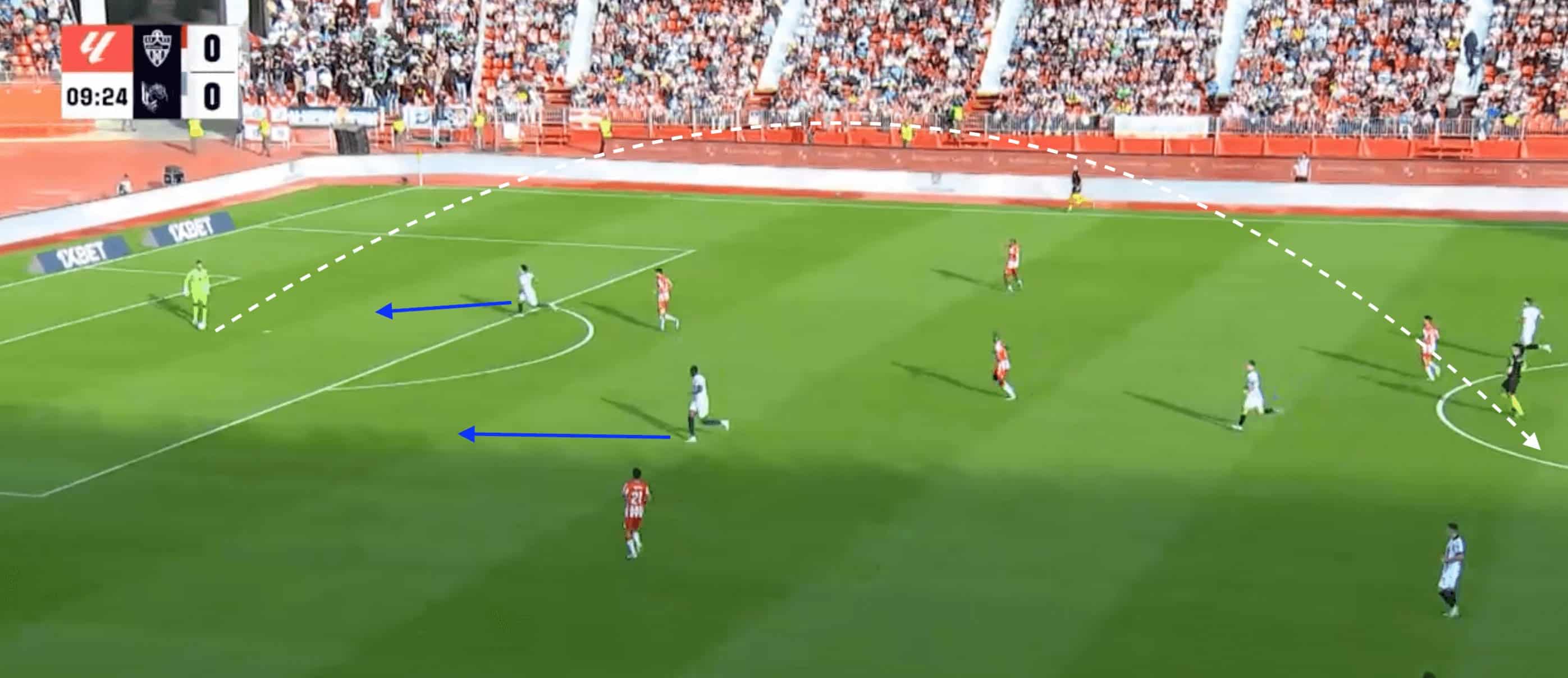
Whilst injuries happen within every club in world football, Almería’s injury history has compounded upon their ability to convert in front of goal. Filled with promise about their summer signings, both Koné and Suárez have spent significant time on the sidelines with serious ankle injuries, with the two major additions combining for just four goals this season. The manner in which these injuries have occurred has also contributed to the negative psychological state of those involved in the club, with many theorising whether the club is just cursed. Having scored an incredible five-minute hat-trick, Suárez was forced off and could only watch on in distress as his side squandered their significant three-goal lead to earn just a point against rivals Granada.
The most surprising aspect of the club rooted to the bottom of the table would be that their statistical attacking data would suggest they have been extremely unlucky not to pick up more points. Almería’s 36.3 xG sees them placed 8th highest amongst their peers in LaLiga, but having only scored 28 actual goals, this would suggest elements of misfortune but, importantly, a severe lack of composure in front of goal. It would appear that for all the creative aspects their 4-2-3-1 formation can be associated with, their lone striker can often be isolated and, frankly, misfiring when it matters.
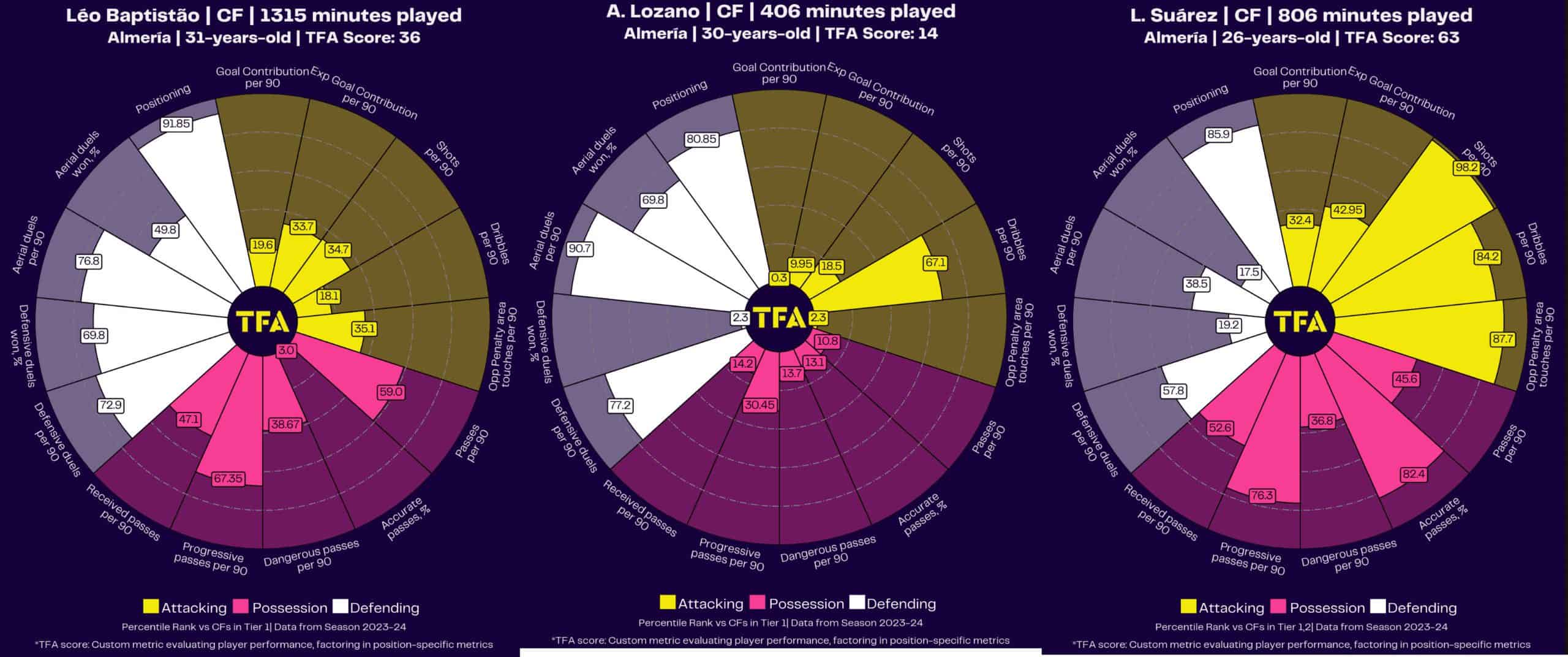
Almería in transition
Almería would appear to look most dangerous when attacking in transition, working the ball toward their dynamic playmakers who can exploit momentary gaps in the opponent’s defensive structure. Despite their passive pressing efforts, they have managed to record 40 shot-ending high turnovers, an impressive figure ranked below only Real Madrid and Barcelona. With an average direct speed of 1.96 m/s, it is evident that Almería looks to break quickly, taking advantage of the direct running and carrying ability of their forwards. However, for all their positive running and ability to target space vacated when the opponent loses possession suddenly, we often see a lack of composure and clinical nature when it comes to the final ball or effort on goal. For a side that often has to soak up pressure and are limited to few key chances, their wastefulness is indicative of their place at the bottom of the table.

On the other side of the ball, we can often see Almería being heavily exploited in transition, often coming from individual errors and a lack of solidity in their defensive line. Despite shifting towards a more conservative style when playing against the league’s elite, with variations of the 5-4-1 and 5-3-2 deployed against Barcelona and Real Madrid, Almería’s persistence with the 4-2-3-1 can cause issues when the positioning of the double pivot is poor. In their recent match against Sevilla, we can see that despite leading later on in the match, their double pivot is incredibly advanced- with creative No.10 Jonathan Viera the one to drop even deeper. As possession is turned over after an intercepted pass, the Sevilla forward has alarming amounts of space to progress into, with ample time to thread a pass through to En-Nesyri and provide a key chance to equalise.
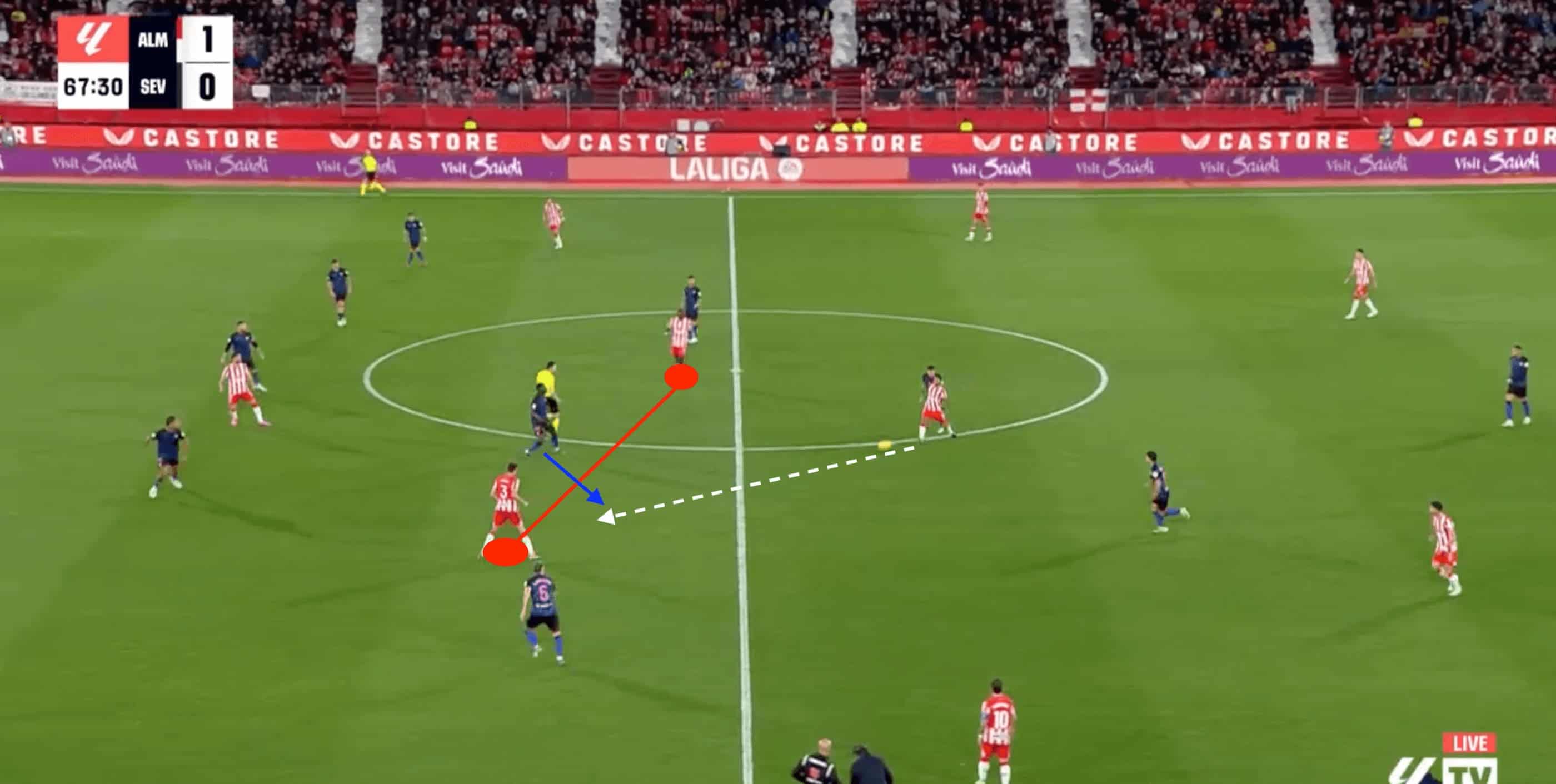
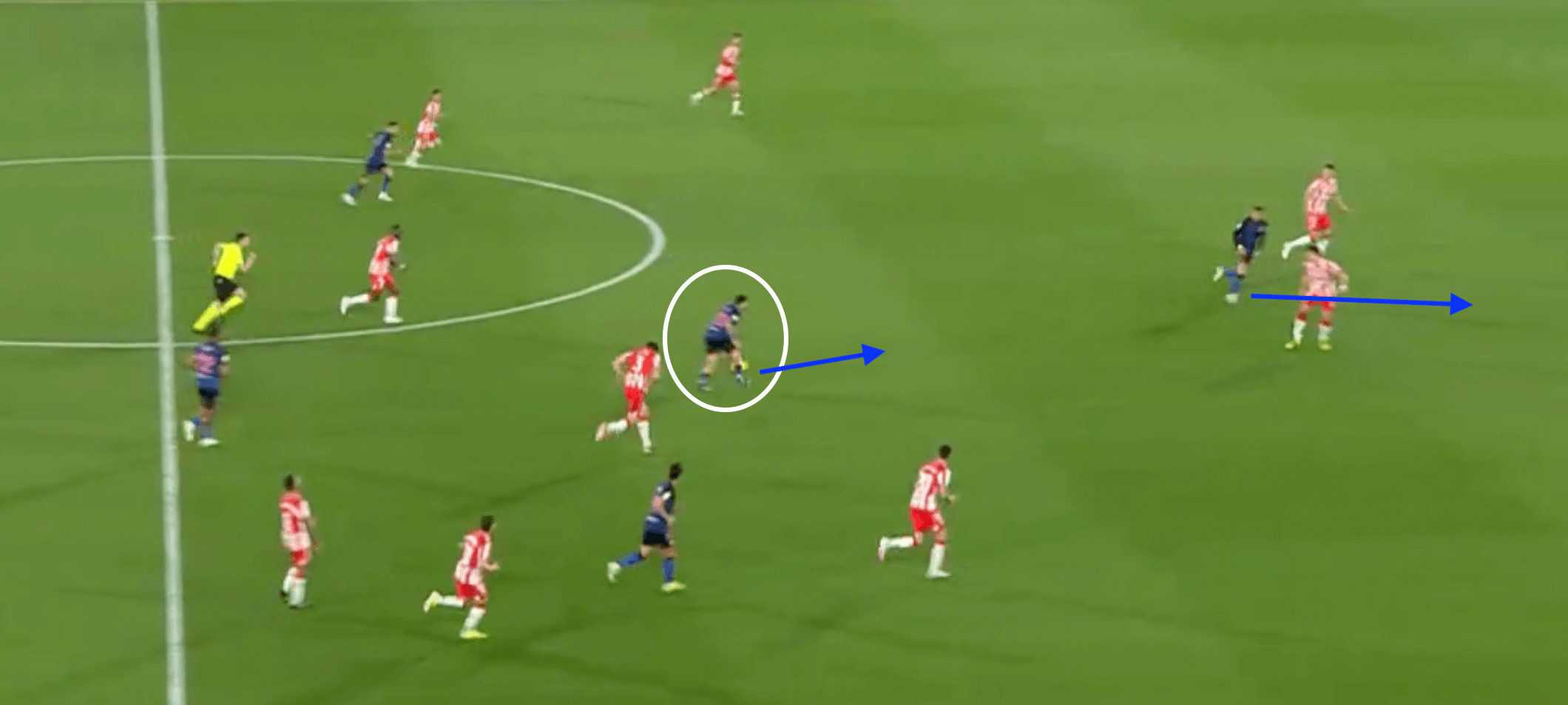
A defensive disaster
The most damning critique of Almería this season would have to be their defensive performances, having been increasingly frail and conceding an incredible amount of goals. Whilst their attacking data would appear promising, the same cannot be said for their work protecting the goal, with 48.6 xGA being the highest figure across Spain’s top flight. Even though some could argue they have been unfortunate to concede 57 actual goals from this expected figure, this detrimental showing would further amplify their inability to be resolute.
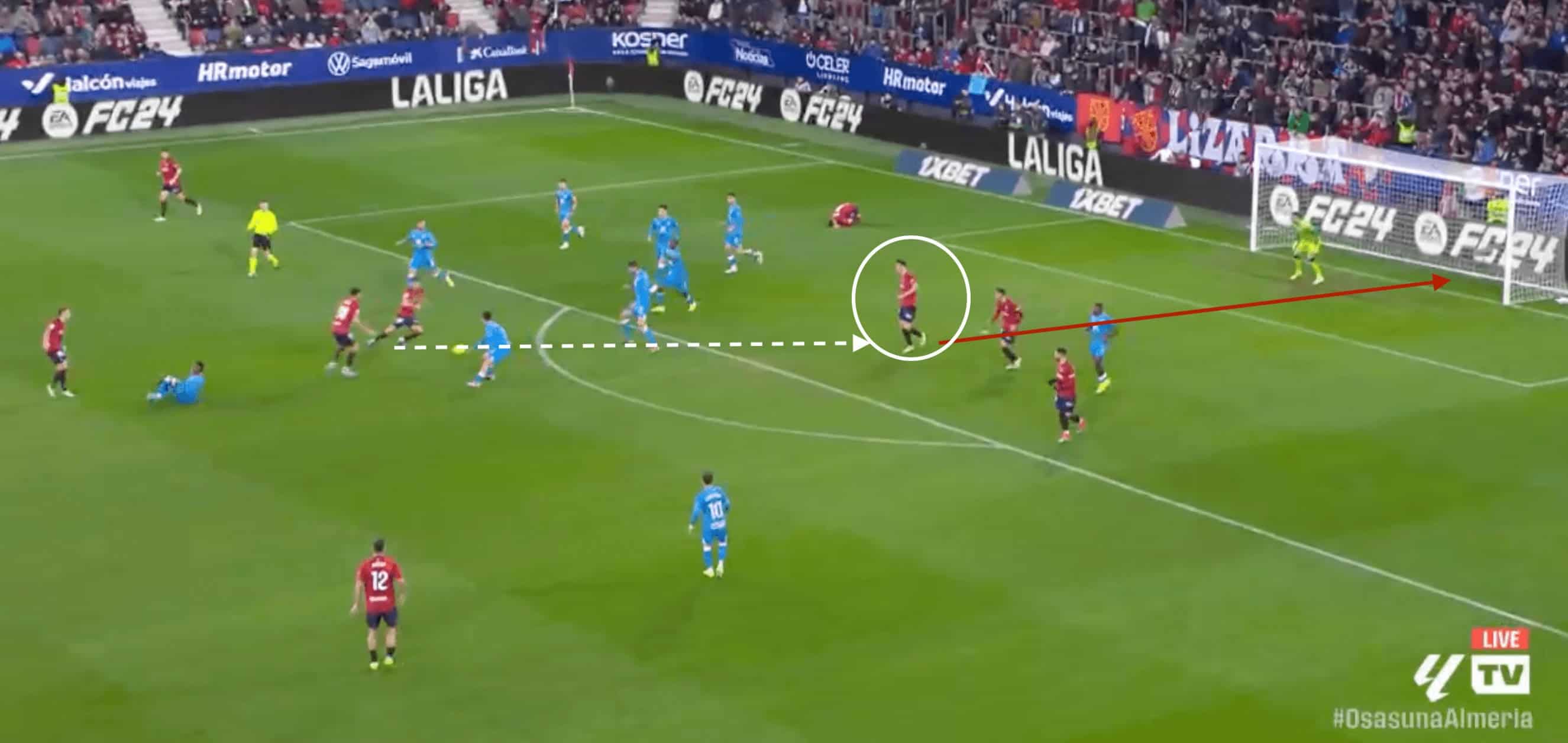
Many important figures around Spain have suggested that whilst Almería’s performances have shown promise, they have been incredibly let down by awful play in both penalty boxes. A switch from Gaizka Garitano towards a more negative style of play had looked to protect their goal a bit more, with an increased amount of clean sheets in tough-fought matches against the likes of free-scoring Girona and Athletic Club. But the overarching mission of achieving wins was no closer to being accomplished due to their consequential lack of inspiration in the attacking third.
Their ability to invite pressure when defending stems from their decisions in the initial phase of the opponent’s build-up. As shown in the image below, they can look to shape up in the 4-4-2 when out of possession, with Viera advancing to form an offensive partnership with Almería’s lone striker. Whilst there are obvious defensive benefits associated with pressing in the 4-4-2, Almería’s lack of a proactive and energetic press and defensive staggering allows the opposition to find space between the lines further forward, with less resistance, allowing the opposition to work the ball forward more effectively. Their PPDA figure of 13.5 and only recording a league-lowest 164 high turnovers all season would be indicative of their submissive nature when defending.
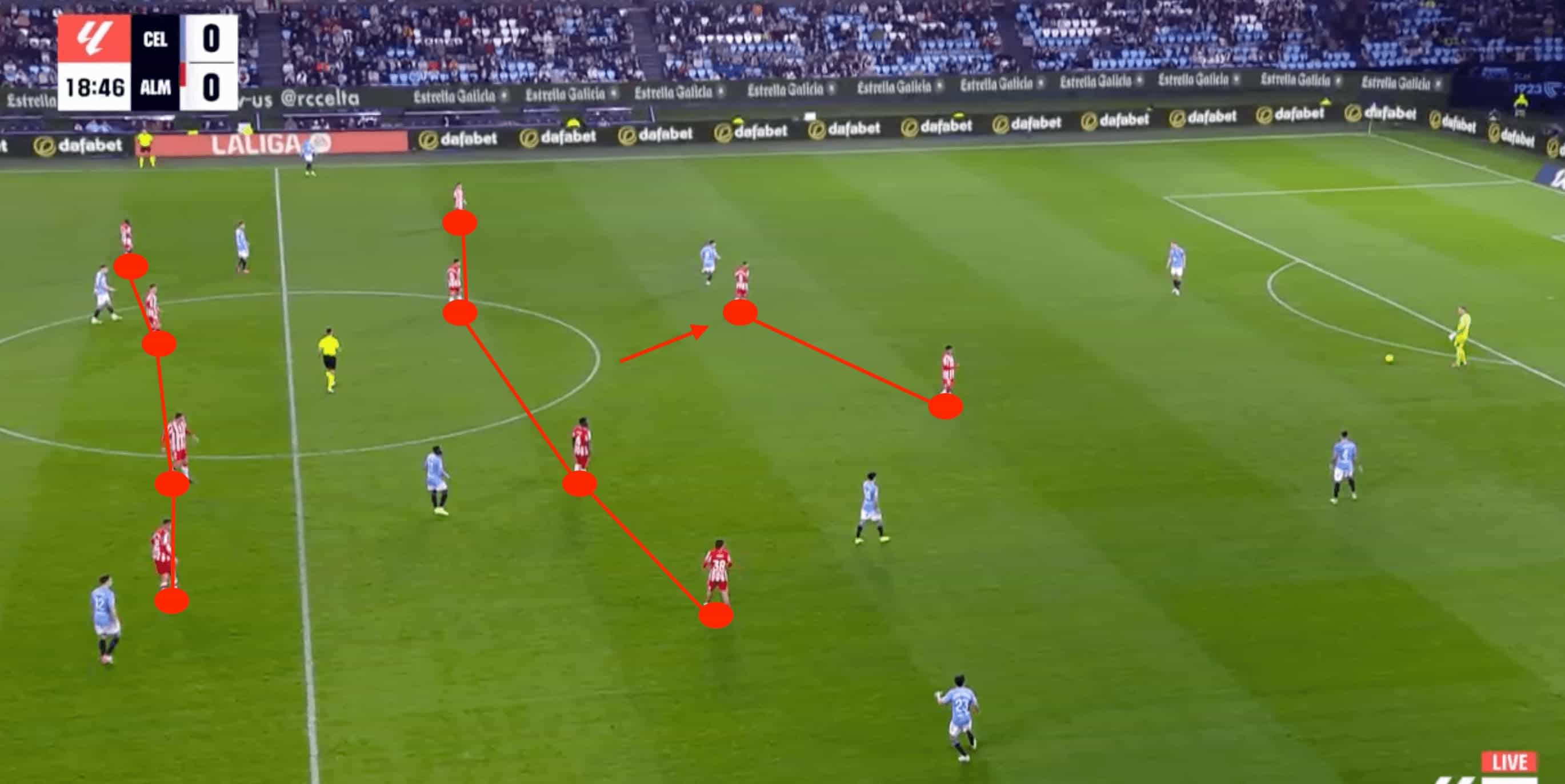
Keys to their first victory
Almería finally broke their curse and achieved their first victory against Las Palmas, ending their 31-game winless run and avoiding Derby County’s embarrassing EPL record of 32 games from 2007/08. In new manager Pepe Mel’s debut match, he was able to reinvigorate his squad, providing a launchpad to push on and avoid further dismay as the season run-in approaches. There were several positive tactical aspects which allowed them to hold their nerve and provide a huge boost of morale as they hung onto all 3 points.
In the attacking phase, Almería’s advanced right back, Marc Pubill, was finding joy with underlapping runs into the half-spaces, offering an integral passing outlet for winger Largie Ramazani. His advancement allowed the Belgian forward to maintain his width and stretch the Las Palmas back line, with smart interchanging passes allowing Almería to progress well along the flank.
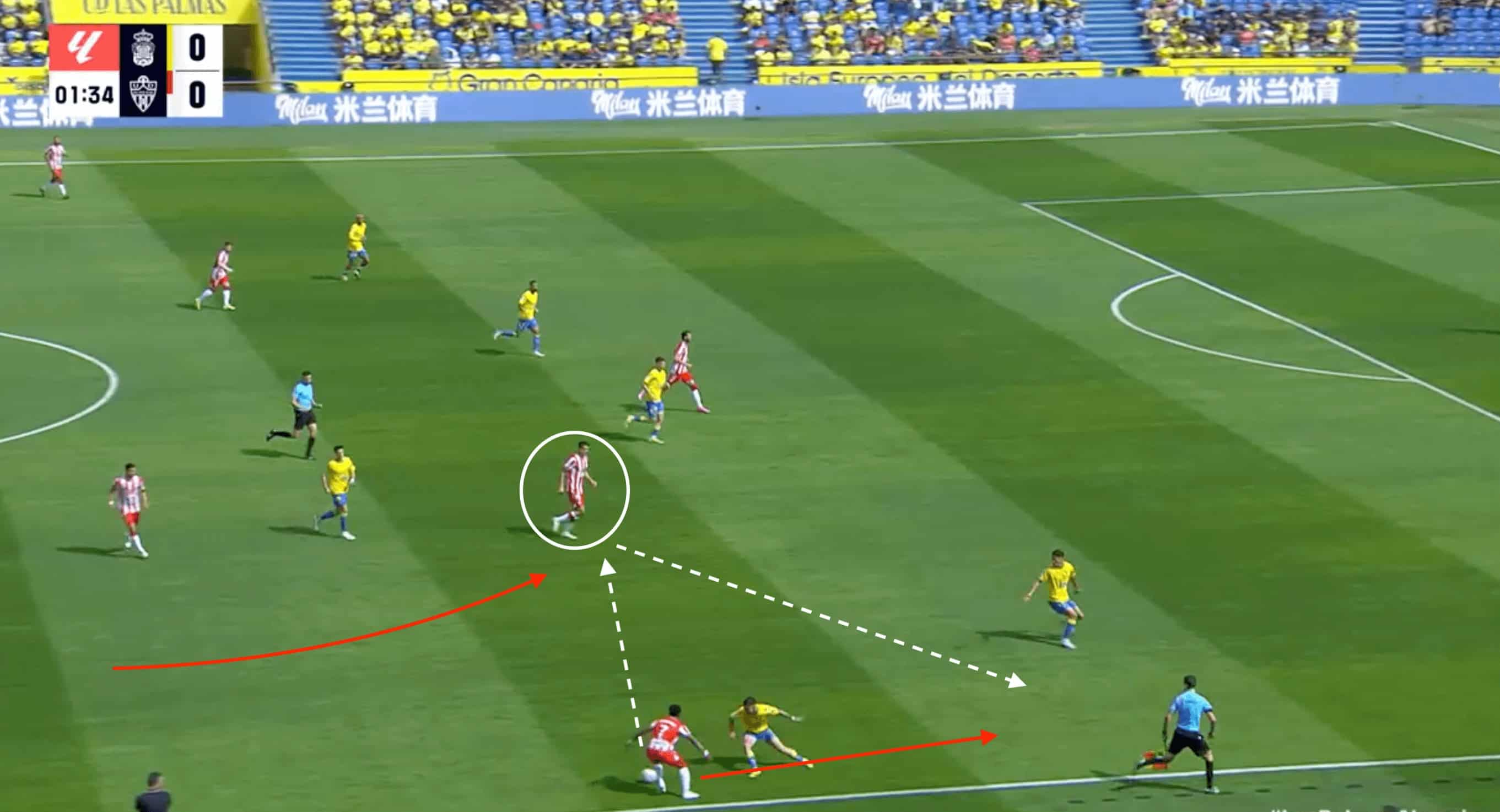
Despite the build-up play still being centred around long passes and not looking to remain patient when playing out, it was crucial in crafting the only goal of the match. Luis Maximiano’s distribution was consistently targeting Jonathan Viera, with the Spaniard finding ample space between the lines and allowing him to bring the ball down with ease. Viera was able to progress forward in space and spread the ball wide towards Ramazani, with Baptistao converting the Belgian’s cross.
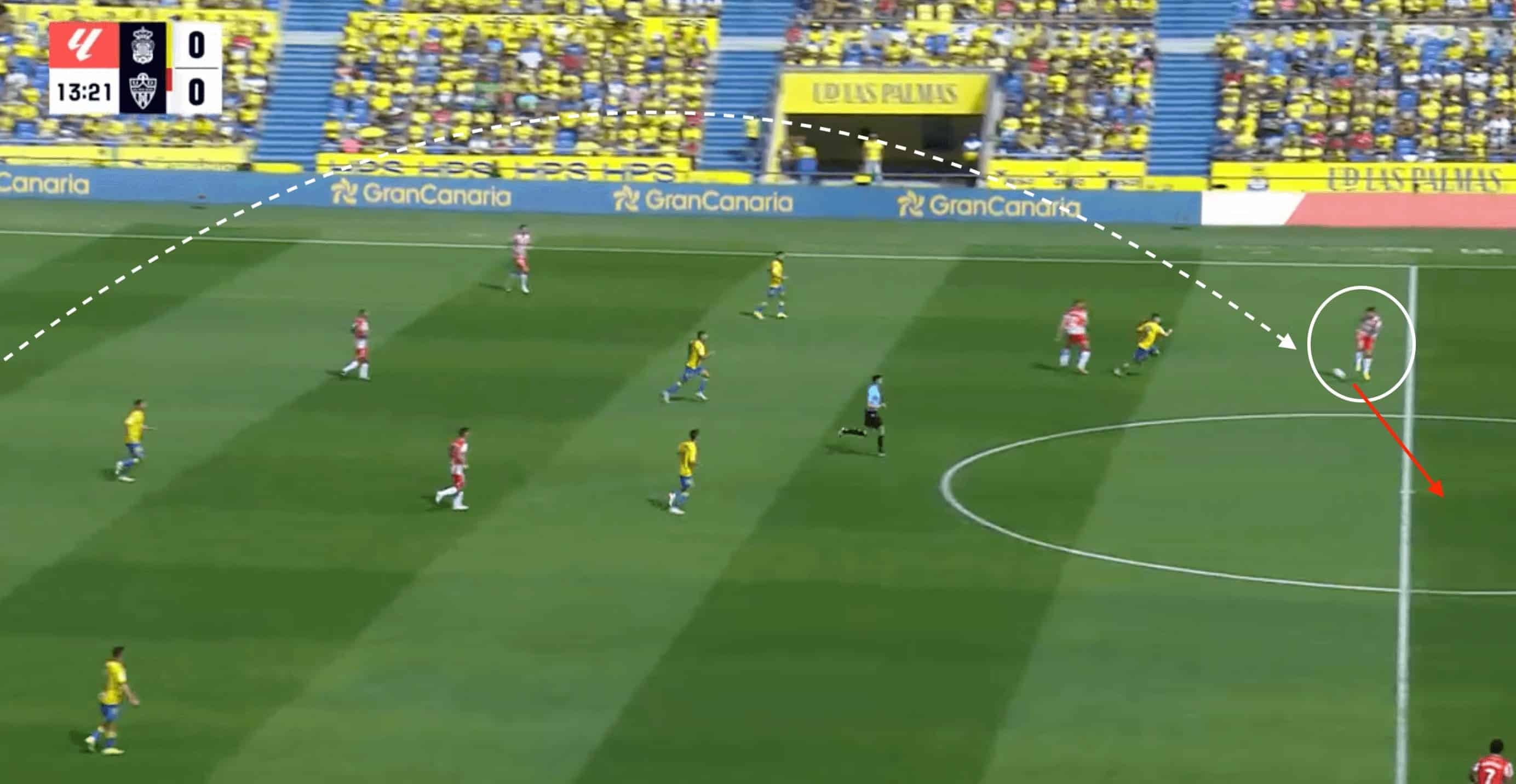
On the defensive side of the ball, Almería had to withstand a Las Palmas barrage in order to hang onto their elusive first win. As we have discovered, Almería’s passive press has allowed their opponents to progress up the pitch with ease, but Pepe Mel’s team were seen to be more proactive, with central defenders stepping up to intercept through passes and regain possession.
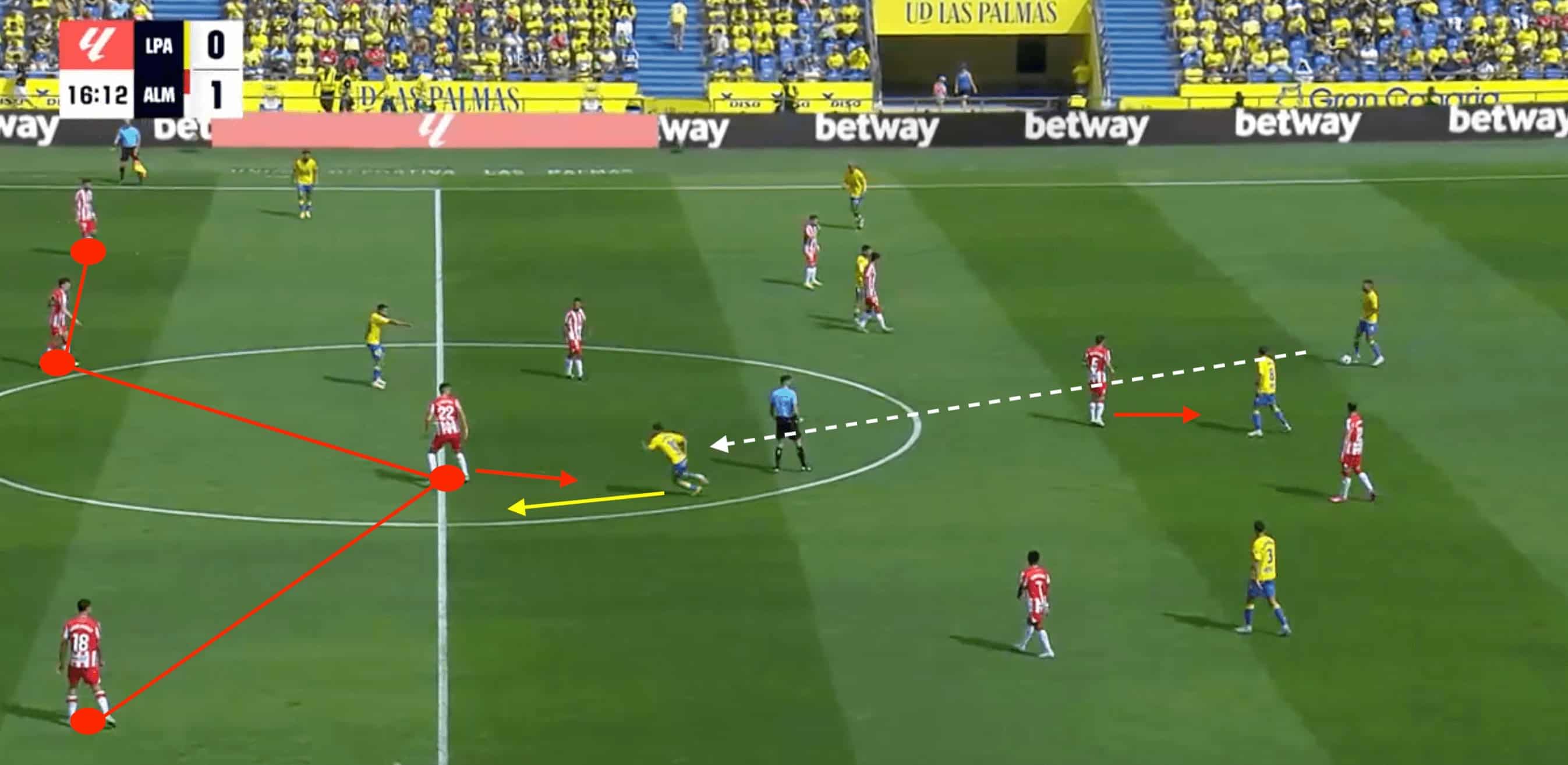
In their deeper defensive state, the double pivot looked to remain tight to the defensive line, in order to minimise space between the two lines and restrict dangerous zones for Las Palmas’ creators to control the ball.
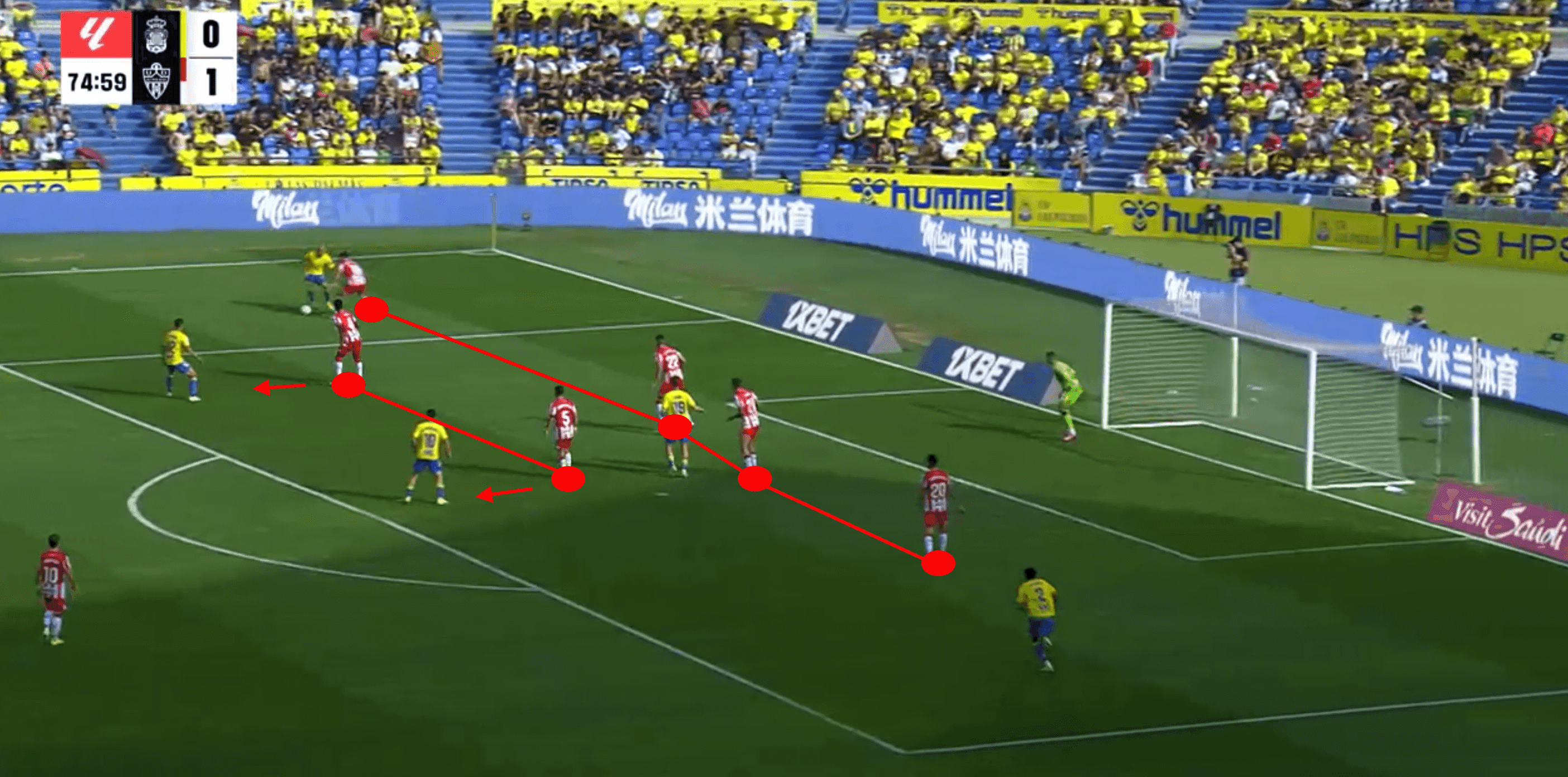
Conclusion
With a win under their belt, Almería will hope to be forgotten from memory rather than remembered for all the wrong reasons. Having reached a total of 13 points thus far, they just need a single point to better the lowest points total recorded by Sporting Gijón in 97/98. What was once a well-oiled side with a clear project for future progression has been undone by a lack of managerial reassurance and an incriminating standard of play at both ends of the pitch. They will hope that with a new face in the dugout, they can kick on and somehow overcome a 14-point deficit- but any hope of such a feat has surely already been lost.





Comments